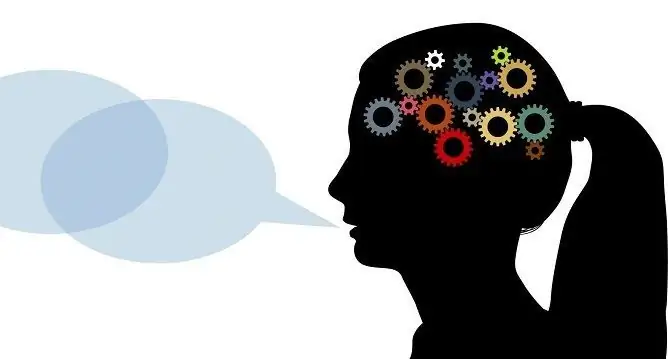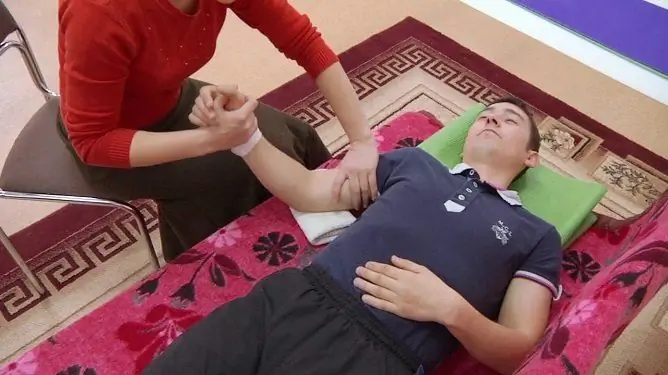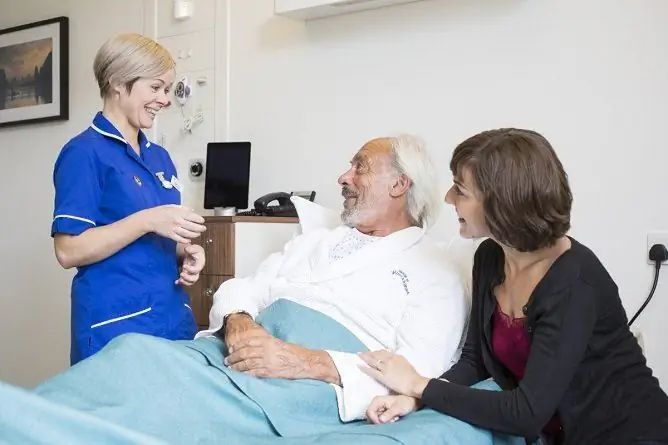- Author Rachel Wainwright [email protected].
- Public 2023-12-15 07:39.
- Last modified 2025-11-02 20:14.
How to restore speech after a stroke: recovery with exercise, medication and folk remedies
The content of the article:
- Why is speech function impaired
- Recovery of speech after a stroke: classes with a speech therapist
- Exercises to restore speech after a stroke at home
- Additional methods of restoring speech disorders
- Forecast
- Video
As a result of acute disturbance of cerebral circulation, various brain structures, including the speech center, can suffer. Articulation disorder is a common disorder in stroke, often it is this that becomes the first sign that allows one to suspect that a stroke has occurred. Speech impairment can be reversible, but it can be a long-term consequence of stroke. In many cases, it can be corrected with special exercises.
Why is speech function impaired
A condition in which a patient after a stroke cannot speak normally is called aphasia. It occurs due to the opening of connections between neurons, an acute violation of their nutrition, compression of the nerve tissue by the hematoma, and also due to any other organic damage to the corresponding structures of the brain. At the same time, it should be understood that the degree of defeat depends on whether a person will be able to communicate normally and pronounce words without difficulty again.

Speech disorders of varying severity are one of the most common consequences of a stroke
Depending on the depth of damage to speech abilities, the following forms of aphasia are distinguished:
- total (complete) - speech is completely absent, the patient may be in a twilight state of consciousness, not recognize loved ones. This is the most difficult form for therapy and speech restoration;
- sensory - associated with a violation of the Wernicke center, which is responsible for speech recognition. The patient hears his native language as completely new, unable to understand what is being said to him;
- motor - disorders are limited to the area of the facial muscles of the face, due to which there is no clear diction in adults who spoke clearly earlier. At the same time, the patient understands everything and tries to answer, but cannot. He is able to fully understand the meanings and reproduce the simplest sounds;
- amnestic - a person's memory of words is damaged, he cannot name the surrounding objects;
- semantic - the patient is able to pronounce only short, simple sentences. He has problems understanding complex speech structures, long sentences.
The type of aphasia is important for the development of tactics and strategies for speech recovery after stroke, since each of them requires a separate program. What to do if the above symptoms are observed?
Recovery of speech after a stroke: classes with a speech therapist
In the first time after a stroke, the main attention is focused on leveling organic damage and preserving vital functions. Rehabilitation of speech usually begins a week after what happened, that is, after the speech has been withdrawn, provided that the patient's condition allows, that is, is sufficiently stabilized. If this is not possible, then speech restoration classes should be started no later than two months after the incident. After this period, the nervous system will recover much worse.
An individual training program is made by a speech therapist, and at first he monitors the exercise. In the early stages, it is worth calling a speech therapist at home - here the most favorable atmosphere is created for the patient. With further progress in restoring speech, speech therapy exercises can be transferred to the doctor's office. Patients who are making progress are shown classes in groups - this technique is highly effective, and patients, being among people with similar disorders, stop being embarrassed. The competitive moment also matters. It is possible to educate relatives of the patient so that they conduct classes with him at home. In this case, the speech therapist examines the patient from time to time, monitoring the progress of recovery and, if necessary, adjusting the program.
In order for speech therapy classes to provide a result, you will need to adhere to the recommendations exactly, to work hard for a long time.
First, the speech therapist examines the patient, analyzes his reaction to quiet and loud speech, gestures, assesses the ability to understand and remember.
Speech therapy techniques are based on the involvement of different brain structures in the speech process. The following exercises are used to restore speech after a stroke:
- Phonetic - aimed at restoring innervation, controlling the facial muscles of the face (especially lips, tongue). The patient is asked to repeat after the doctor a certain sound belonging to one of the categories - labial, hissing, etc. This initial exercise also serves as a diagnosis of the form of speech loss. Both individual sounds and whole tongue twisters are used to develop speech - at first they may seem too complicated, but even unsuccessful, but regular attempts to pronounce them lead to positive dynamics.
- Semantic - the patient must include active thinking and find new meanings in the proposed situations, for example, continue a sentence, associative array. The patient may be asked to enter into a dialogue with the doctor on some neutral topic.
- Visual, figurative. For people with sensory aphasia, the method of illustration is used. Illustrations from books, special manuals, or picture cards are used. Such exercises encourage you to find appropriate connections and sequences.
- Creative. This group includes singing, music lessons, art therapy, etc.
During the session, the speech therapist (and later a close person who replaces him in the classroom) adheres to the most patient-friendly moods - he pronounces all the words loudly and clearly, politely addresses the patient, shows patience. This is important for stroke patients who are often embarrassed about their condition, feel helpless, and experience physical difficulties (for example, when the right side of the face is paralyzed or the tongue is twisted). A comfortable relationship between doctor and patient is the key to successful treatment.
In the first weeks after a hemorrhagic or ischemic stroke, you can get by with classes for 10-15 minutes. Gradually, the duration of the classes is increased.
If the help of a specialist was not provided on time, then the speech center will soon cease to perform its functions, and it will be much more difficult to restore speech. A speech therapist-aphasiologist is involved in the treatment of such patients.

To speed up the recovery of speech after a stroke, doctors may prescribe medications that help restore the functioning of the central nervous system. These include the original nootropic drug Gliatilin (choline alfoscerate). The phosphate form of the drug enables Gliatilin to be better absorbed and to restore damaged brain cells as quickly as possible, which contributes to the restoration of speech, memory and thinking. Choline alfoscerate protects brain cells from further damage, even with impaired circulation or insufficient oxygen saturation. Gliatilin improves the transmission of nerve impulses and has a positive effect on receptor function. The drug is well tolerated by patients, is contraindicated for use by pregnant women, lactating women and people with hypersensitivity to choline alfoscerate.
Exercises to restore speech after a stroke at home
In addition to training with a specialist, the patient continues to exercise independently or with the help of relatives. Those, in turn, should talk a lot with the victim, take him patiently, be friendly and understand that only with prolonged persistent studies and shown perseverance, this pathology is reversible.

Gymnastics for lips and tongue should be done daily.
Exercises aimed at developing lips:
- maximum extension of the lips into a tube;
- gripping with one lip with the other, then vice versa;
- pulling the lips with fingers to the sides, up and down;
- a broad smile, alternating with a sad expression on his face, drooping corners of the lips.
Exercises for developing a language:
- maximum protrusion of the tongue from the oral cavity;
- alternately touching the sky with the tongue, then the bed under the tongue;
- licking the lips with circular movements, changing the side of rotation;
- rounding the tongue back as far as possible;
- movement of the tongue along the inner surface of the cheeks and lips in different directions.
The patient is also encouraged to read aloud, starting with simple sentences, such as article headings or nursery rhymes, slowly, trying to pronounce the words clearly and distinctly.
The duration of classes is initially short - 3-5 minutes, then it is gradually increased, bringing it to 10-15. It must be borne in mind that it is not so much the duration of one lesson that is important, as their regularity.
Normal circulation of impulses in the brain is resumed only in the presence of constant loads, so you should exercise daily.
Additional methods of restoring speech disorders
To maintain the activity of the nervous system and better assimilation of information, drugs can be prescribed that help improve cerebral blood flow - the so-called nootropics. They enhance cerebral circulation, accelerate the growth of nerve fibers. Drug therapy helps to restore memory, stimulate thinking.
Physiotherapy is also effective - electrical impulse stimulation of facial muscles, face and tongue massage.
Folk remedies can also help: decoctions and infusions of viburnum, pine cones, juniper, thyme, plantain, St. John's wort, strawberries, sage, rose hips, calendula and other plants. You can collect plants yourself or in pharmacies, individual herbs or ready-made collections.

Sage tea is one remedy that can be an effective adjunct to drug therapy for aphasia
Complex therapy continues until speech is fully restored, or until the intensified exercises cease to bring results.
Forecast
It is impossible to guarantee complete recovery of speech after a stroke. Success depends on the localization of the lesion in the brain, the regenerative abilities of the body, the conditions in which the patient is, his determination, patience and perseverance. Patients with more severe forms of the disease, which were accompanied by extensive damage to the brain structures, recover longer, and the chances of their full recovery are lower. Nevertheless, in most cases, speech can be restored, if not completely, then in sufficient volume so that a person can communicate with others.
The detailed forecast looks like this:
- in the absence of adequate treatment, the chance of restoring speech activity after its loss as a result of a stroke is approximately 15%;
- with severe stroke, but observing the full range of therapeutic measures, the chances of full recovery increase to 55%, with moderate stroke - 75%, with mild stroke - 90%.
Therefore, the answer to the question "how to restore speech after a stroke?" next: start treatment in a timely manner, under the supervision of a doctor, do exercises regularly and persistently, be patient and do not give up classes, even if the result is not as quick and obvious as expected.
Video
We offer for viewing a video on the topic of the article.

Nikita Gaidukov About the author
Education: 4th year student of the Faculty of Medicine No. 1, specializing in General Medicine, Vinnitsa National Medical University. N. I. Pirogov.
Work experience: Nurse of the cardiology department of the Tyachiv Regional Hospital No. 1, geneticist / molecular biologist in the Polymerase Chain Reaction Laboratory at VNMU named after N. I. Pirogov.
Found a mistake in the text? Select it and press Ctrl + Enter.






